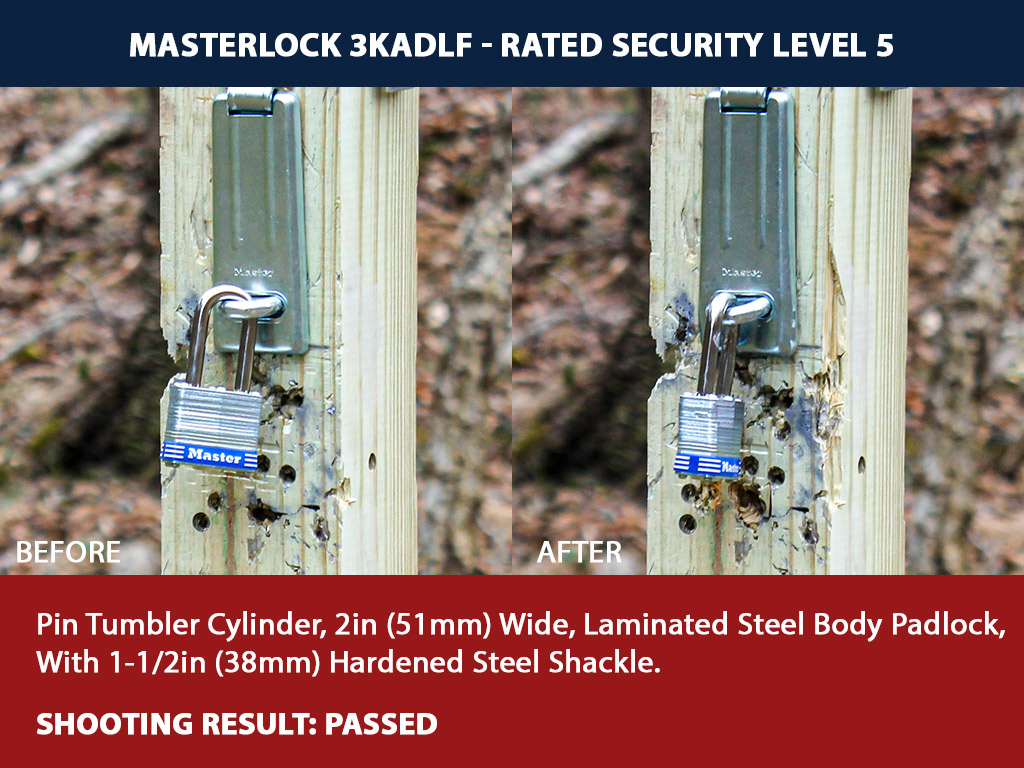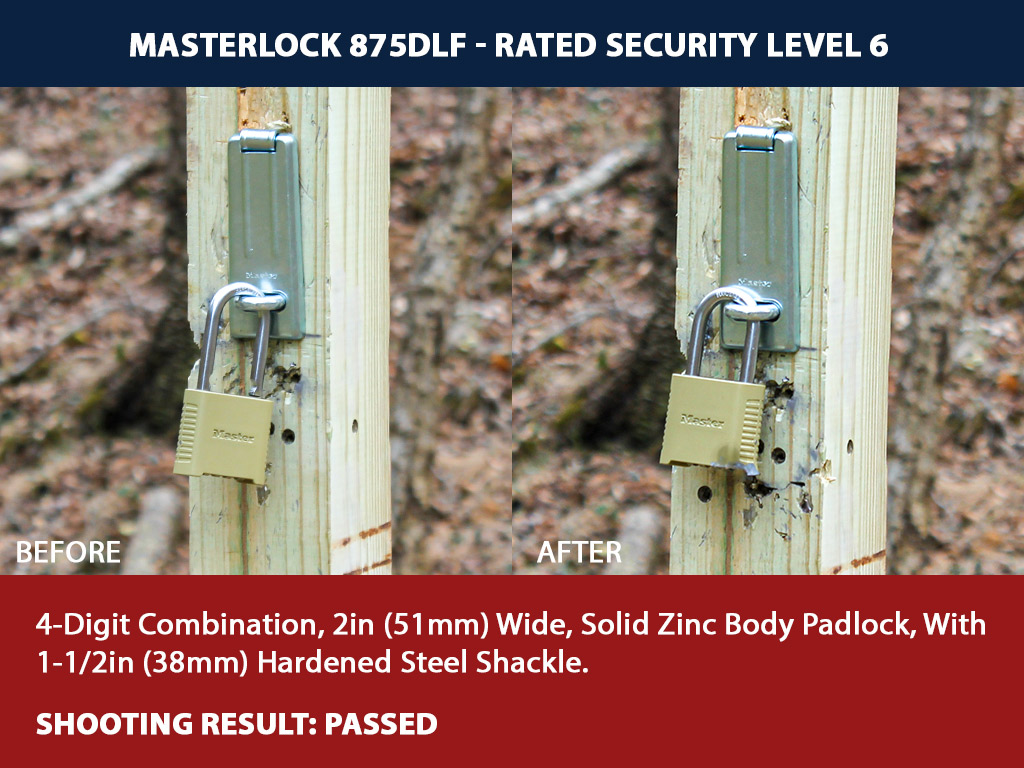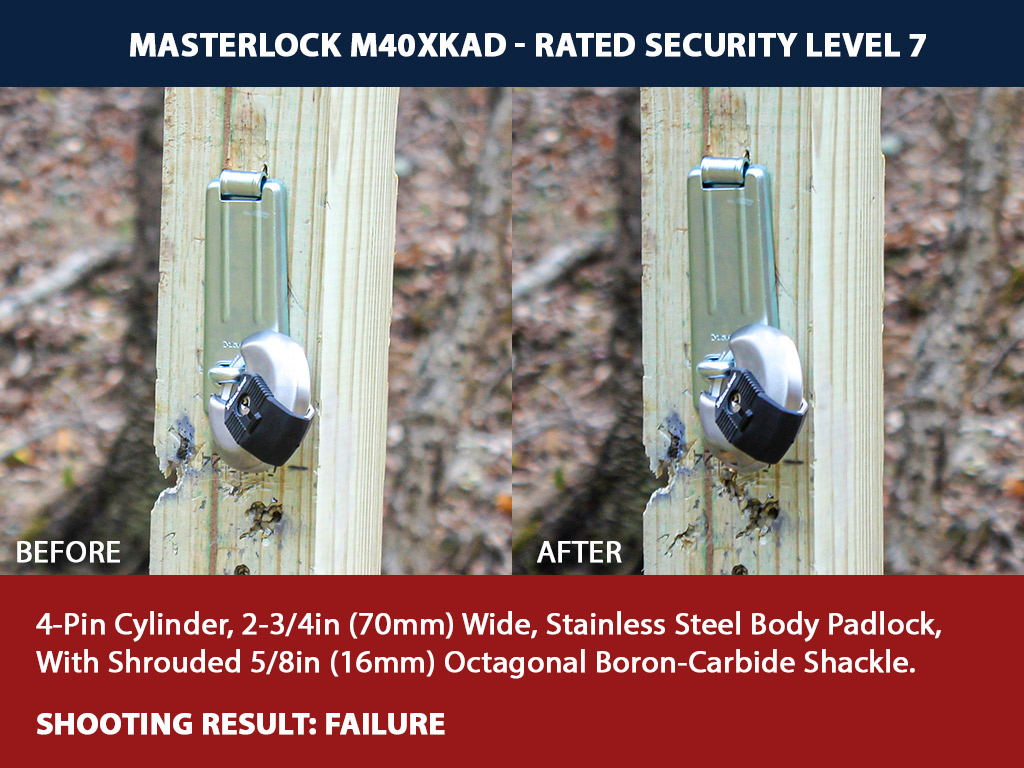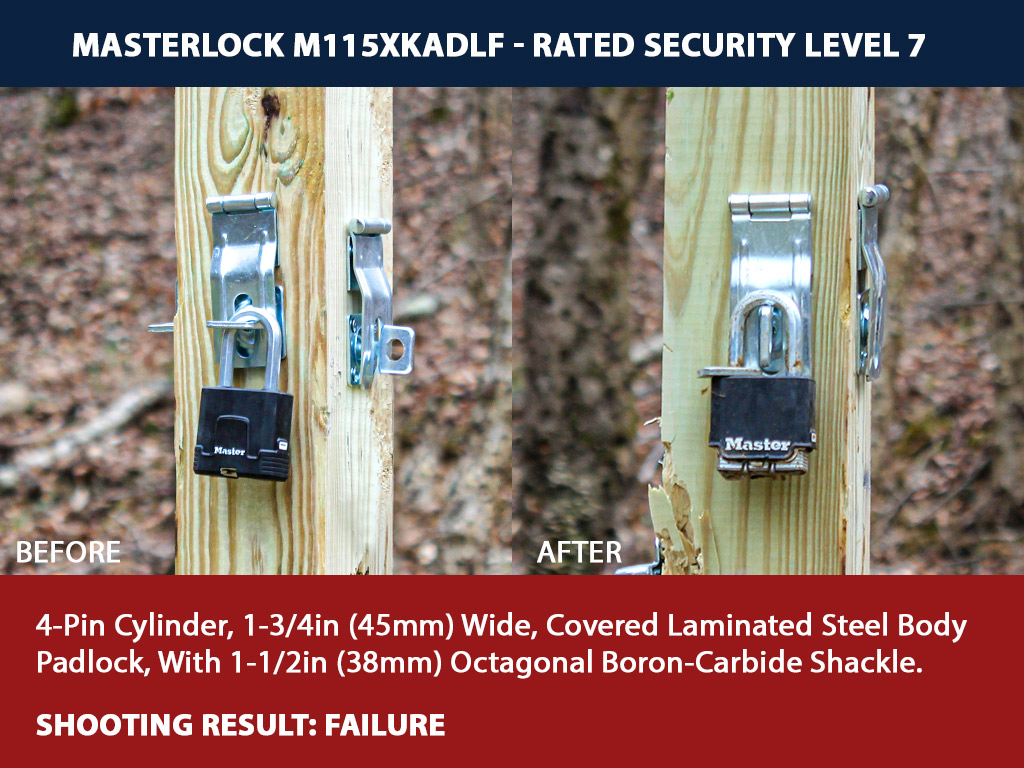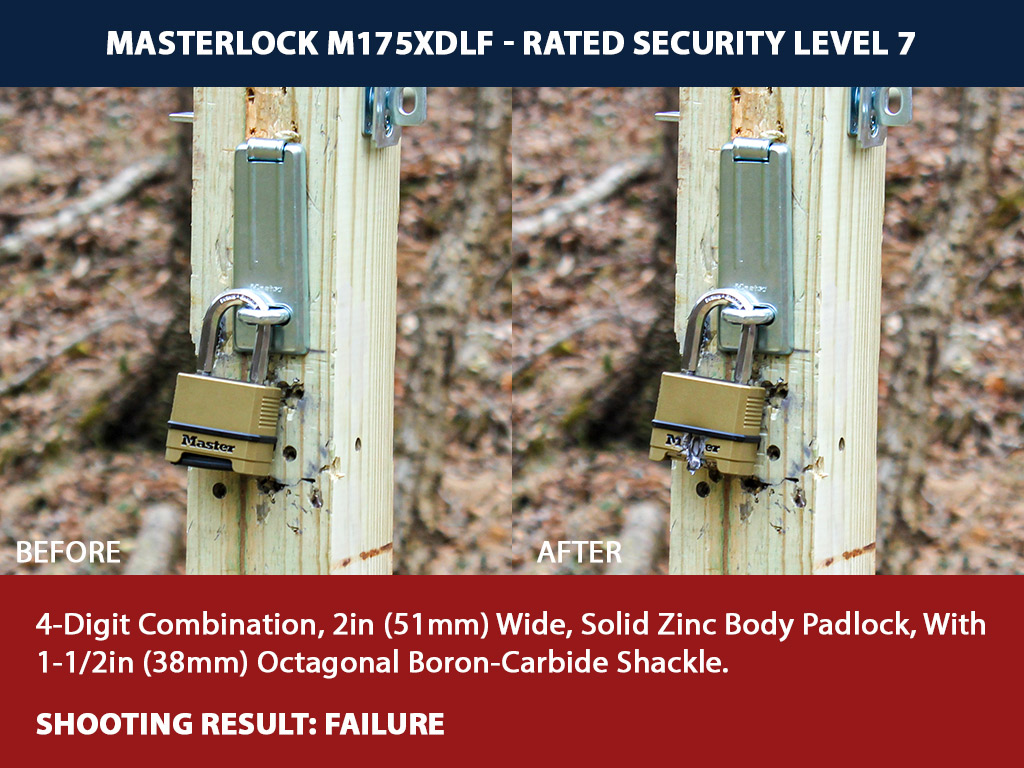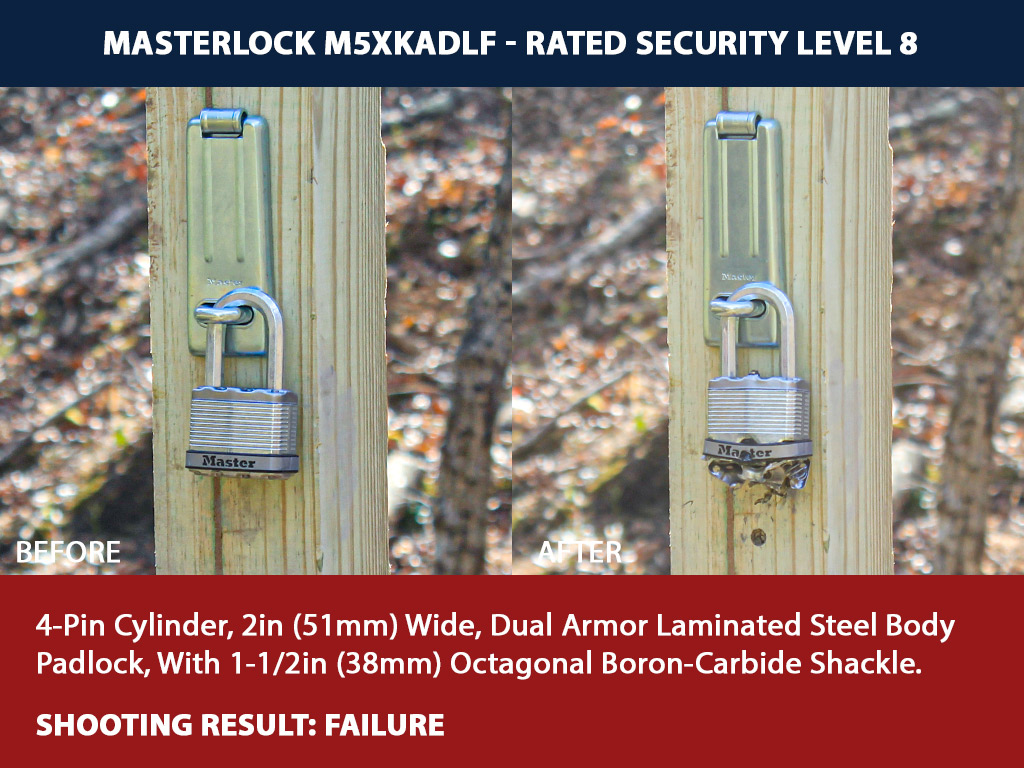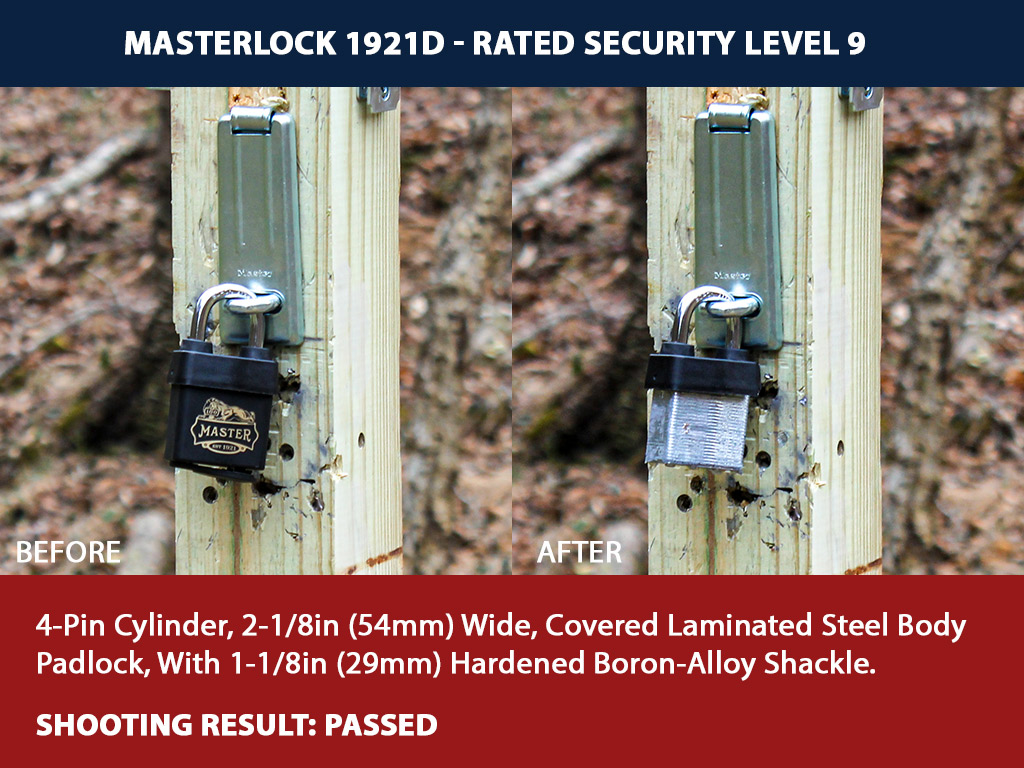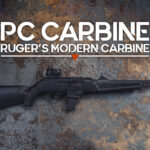
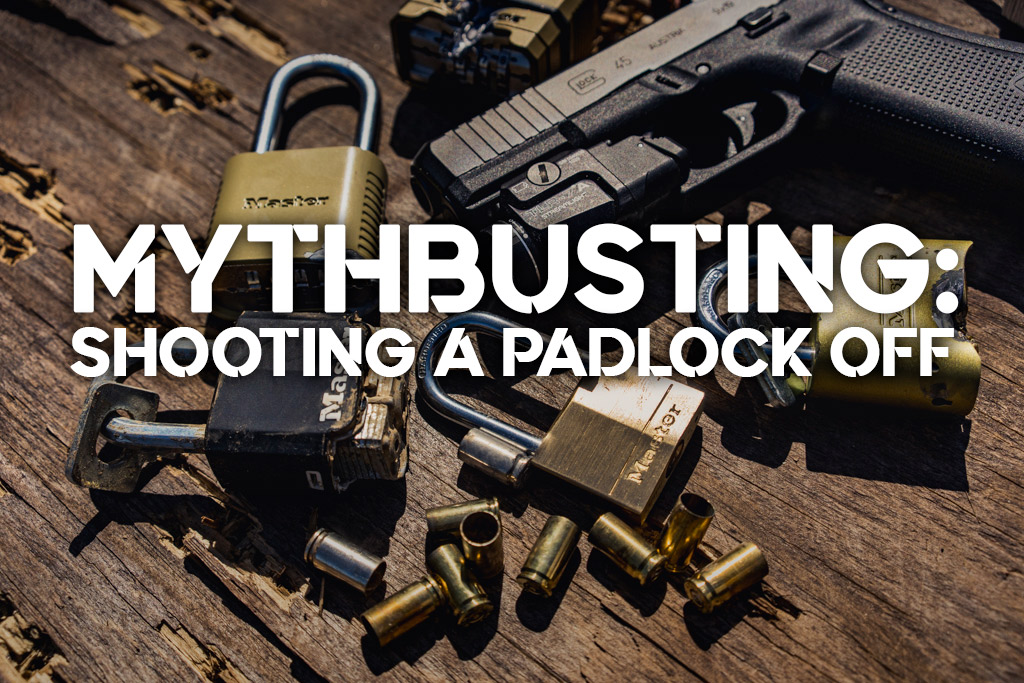
Guest Writer: Kenzie Fitzpatrick
Have you ever wondered how much of the action in a Hollywood film is real, and how much is fake? We were curious ourselves, so we set out to prove or bust the myth that shooting a padlock will cause the lock to fail. We hypothesized that most padlocks wouldn’t fly off (like in the movies) when they are shot at close quarters. However, we were pleased to find that the build quality of the padlocks greatly affected the failure rate of the locks during our testing.
Testing Goals
We purchased ten padlocks to find out what really happens when you shoot them with a handgun. We ended up with ten padlocks all made by the Masterlock brand. The padlocks feature a variety of security ratings, assigned by Masterlock, ranging from 4-9. Why Masterlock, you may ask? Well, that’s the only brand our local hardware store carried if we’re being honest.
We figured buying padlocks off of a store shelf would make the test more realistic to the type of consumer-grade locks you might have to shoot off out in the wild. They may not be fancy padlocks like Abloy, Medeco, or Abus, but they work just fine for real-world testing. They’re locks the average consumer could buy to secure their property without needing a Hollywood budget.
Testing Procedures
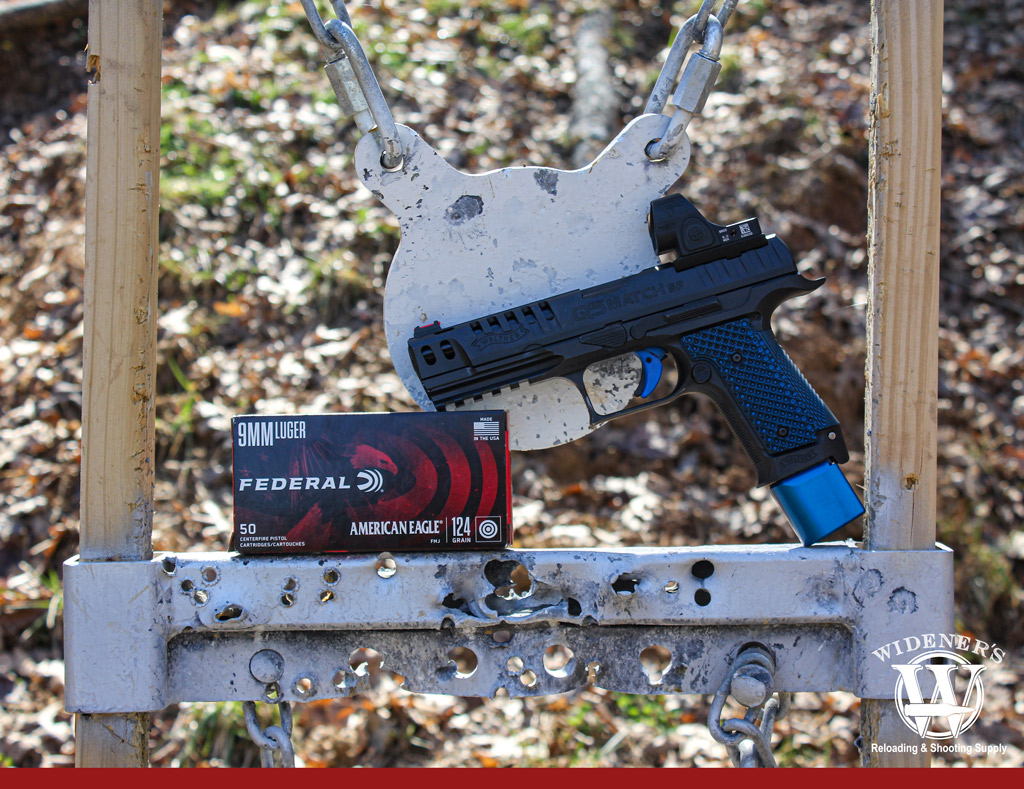
Will shooting a lock cause it to fail? We’ll answer that question and more in the article below.
For consistency, we shot all of the padlocks with the same ammunition, Federal American Eagle 9mm 124 Grain FMJ. We used the same handgun, a Walther Q5 Steel Frame with Trijicon SRO as a constant during the testing. We shot each padlock from a distance of ten feet away. Why 10 feet? Well, for safety and for another good reason: The shrapnel from a few of the locks made us question how safe it is to shoot a padlock at close quarters.
We fired a round at each padlock’s center mass and tested for functionality to see if the shot caused a failure or catastrophic failure. How difficult is it to shoot a lock at ten feet? It’s more difficult than you might think. If a shot winged, or clipped the edge of the padlock during testing, we fired another shot until we hit center mass. We only used the data collected from center mass shots to log failures and catastrophic failures in this test.
For this test, we define a failure as the padlock being incapable of operation after being shot. That means, you can’t open the padlock, either by key, or by numerical combination after shooting it. In the event of a failure, the padlock will remain locked, fulfilling its intended purpose to secure your property.
For this test, we define catastrophic failure as the padlock failing to remain locked after being shot. If a catastrophic failure takes place, the padlock is incapable of operation, as well as suffering noticeable physical damage to the exterior/interior.
Padlock Security Explained
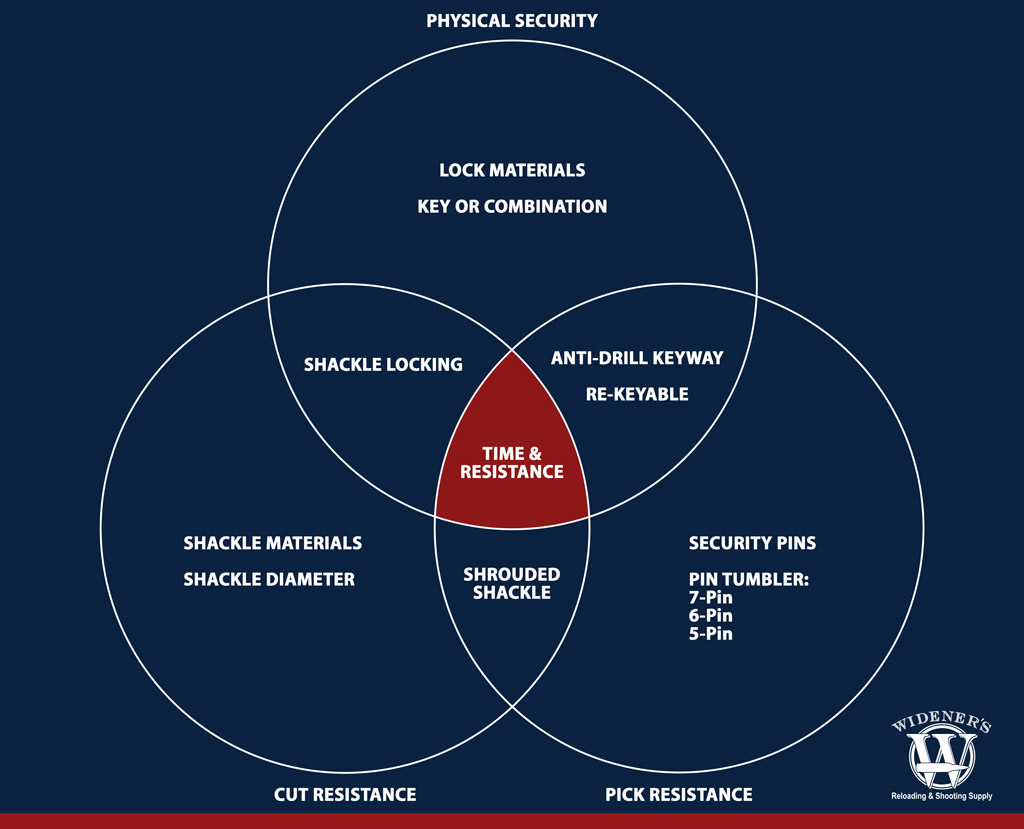
Padlock security ratings can be confusing, it’s easier to think of the ratings for security as connected groups.
Trying to explain the logic behind lock and safe security ratings is a can of worms. Essentially, all security ratings are based on the level of protection provided, measured by the time it takes to compromise the security using a series of pre-defined techniques. If that explanation sounds like the beginning of a Calculus proof to you, you are not alone.
Who Issues Lock Ratings?
In the United States, several groups provide industry-standard security ratings for locks, safes, parts, and accessories. The main group is UL (Underwriters Laboratories), followed by BHMA (Builders Hardware Manufacturers Association), and ANSI (American National Standards Institute). Our friends across the pond in the EU have their own group, the European Committee for Standardization, and security rating standards known as CEN (Central European Norm).
There’s a seemingly endless amount of combinations (pun intended) for lock security ratings. They are based not only on the actual devices, but also on the individual parts and materials of the devices. These ratings apply to parts and accessories such as (but not limited to) lock cylinders, shackles, bolts, and latches. You can think of these security ratings in groups (think of the Venn diagram above), whereby certain features, accessories, and materials may be in one, or multiple groups.
All that to say, it isn’t easy to understand the security rating of a lock when making a purchase. You’ll need to look up the security features of the lock (if they’re even listed) and decide if they meet your needs for securing your personal property. There’s no easy five-star industry-standard rating system in the US for locks and safes. In Europe, the CEN does have a numerical rating system, but it too is based on a contingency of features, accessories, and materials from various groups.
Masterlock’s Security Ratings
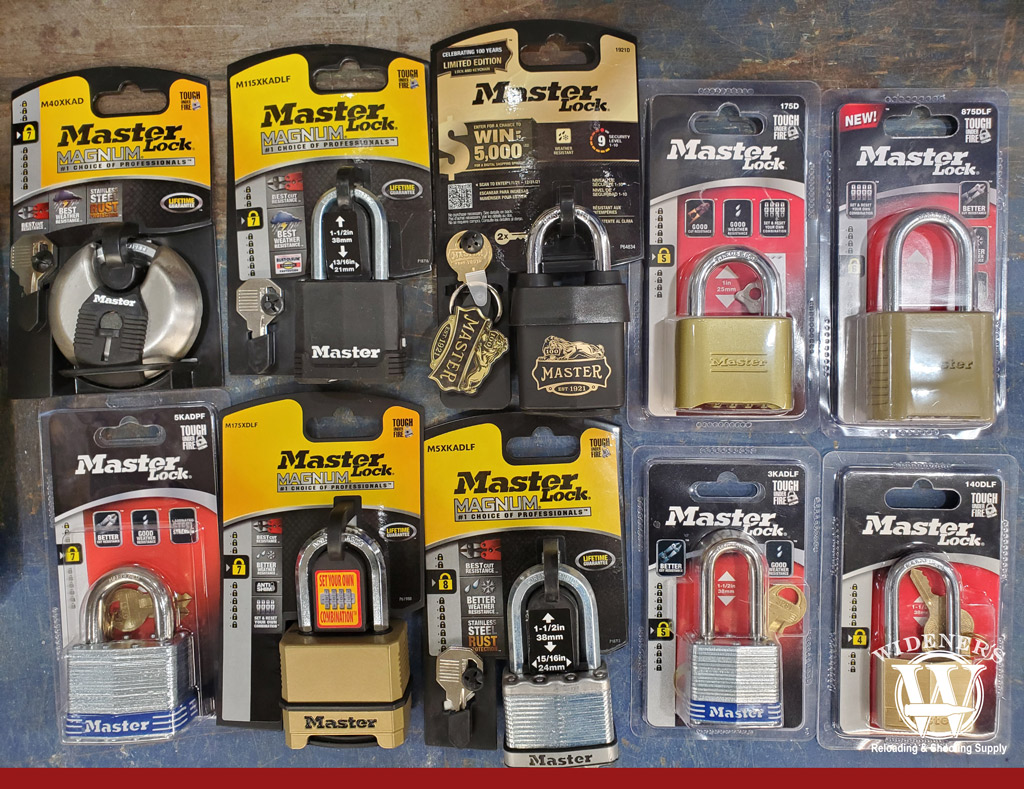
Masterlock uses its own proprietary security rating scale to advertise its products to consumers.
If there’s no numerical industry-standard rating system for padlock security, why does Masterlock use one for its products? We wondered the same thing. The Masterlock brand padlocks we purchased all feature a prominent 1-10 security rating (1 being low-security, 10 being maximum-security) on the front of the packaging. However, there is minimal explanation on the packaging, or in the included instructions about their proprietary security rating scale.
Surprisingly, we couldn’t locate a single padlock description on the website that included the same 1-10 security rating scale as was found on our packaging. However, we did find a detailed explanation as to which features Masterlock considers to be either low, or high security for their products. Based on the provided information, we can conclude that Masterlock is indeed using existing group industry standards to create their proprietary security rating scale.
Are Masterlocks Bullet Proof?
The packaging for each Masterlock we purchased features an image of a lock with a bullet hole in the upper right-hand corner. The phrase “Tough Under Fire” accompanies this graphic, potentially suggesting to consumers that the lock they are purchasing is tough enough to survive a gunshot. After carefully reading each package and included instructions, we could not find any additional language making claims about the ability of Masterlock products to survive a gunshot.
Here’s where we separate the fact from the fiction. Keep reading to see if we bust this myth wide open, or just ruin a bunch of padlocks:
Shooting A Padlock Off
Masterlock 140DLF – Rated Security Level 4
Some early action! Looking at the quality of this lock compared to the others, it was a dead giveaway that it was a low-security padlock. This lock felt flimsy and was nowhere near the thickness or weight of the other locks tested. One-shot to the body of this padlock and the lock and shackle completely separated. The shackle and lock went flying into the air and upon further inspection, we found that it suffered a catastrophic failure. Masterlock advertises this lock for securing backpacks, briefcases, cabinets, and marine security. We would suggest buying a lock with a thicker body and shackle to secure your personal belongings.
Masterlock 175D – Rated Security Level 5
This padlock was the first combination lock we tested. One interesting feature about this lock is that it requires the owner to rotate the keys to a number that is not the combination for it to lock in place. This means that if the lock fails to unlock because of keys not rotating, you’ll be stuck with no access to your belongings. The failure occurred when the bullet hit center mass above the combination cams. The impact crushed the combination cams. It caused them to be permanently stuck on the number they were set on. After being shot, the lock stayed securely on the hasp with no way to unlock it or remove it.
Masterlock 3KADLF – Rated Security Level 5
This mid-rated security Masterlock convinced us that causing a catastrophic failure by shooting a lock would be unlikely. The laminated steel body of this lock is tough. The impact of the bullet was able to warp the metal body so the lock twisted a bit around the edges, but the lock was still functional. We were able to lock and unlock it after shooting it. This one gets a passing grade for our testing.
Masterlock 875DLF – Rated Security Level 6
This combination lock took a solid bullet hit and the only damage was a loss of some of the metal from the frame. After being shot, we could still lock and unlock the padlock. Masterlock advertises that the lock is rated for superior weather resistance. We hypothesized that the slick-coating on the exterior of the lock may have helped protect it from the impact of the bullet. This padlock gets a passing grade for our testing.
Masterlock M40XKAD – Rated Security Level 7
This padlock performed similarly to the security level 8 rated lock when shot. The bullet compressed the outer shell and caused the shackle to become permanently locked. The internal cylinder was crushed by the impact of the bullet causing the failure. The key was able to be placed into the keyhole, but we weren’t able to turn the key once inserted. The stainless steel shell was not penetrable by the bullet and, as noted, the padlock stayed securely locked after being shot.
Masterlock 5KADPF – Rated Security Level 7
This security level 7 rated Masterlock performed well in its duty. The lock had a solid “shiner” on it from the bullet impacting the surface. When shooting a lock, it’s common for there to be shrapnel, not so with this sturdy model. The lock was able to take a key and unlock and relock with no problems after being shot. This padlock gets a passing grade for our testing.
Masterlock M115XKADLF – Rated Security Level 7
This high-security-rated lock features a weather-resistant cover over its laminated steel body. How did it hold up? Not so great. The outer shell on this lock cracked and the bottom half flew off, but the lock remained intact. The bullet impact forced the lock to twist slightly resulting in a failure. The keyhole was impacted enough that the key was not able to be inserted back into the lock. The shackle of the padlock stayed securely locked in place after being shot.
Masterlock M175XDLF – Rated Security Level 7
This combination Masterlock does not require a tool to change out the combination. Even with the high-security rating of a 7, the lock did not take a bullet well. The combination cams were blown out to a point where they were stuck permanently. The damage to the numerical keys caused a failure. This padlock won’t be able to be unlocked by the owner or a criminal in the future.
Masterlock M5XKADLF – Rated Security Level 8
This lock’s high-security rating gave us high hopes that it would survive being shot. For the most part, we were right, however, the lock did technically fail. The impact of the shot crushed the cylinder so that we couldn’t insert the key into the lock. The shackle of the padlock stayed securely locked in place. Despite this damage, there was no catastrophic failure of the lock itself. The dual armor exterior was highly durable and deflected the bullet well.
Masterlock 1921D – Rated Security Level 9
This padlock had the highest security rating we could find at our local hardware store. It is branded as the Masterlock 100 Year Celebration Limited Edition. It’s a covered, weather-resistant laminated steel padlock. This lock took a center-mass hit from a full metal jacket 9mm, but the bullet was no match for this limited edition lock. The limited-edition cover went flying on impact, but the laminated steel protected the cylinder. The lock was able to accept a key and unlock and relock with ease after being shot.
Why Not Shoot The Shackle Off?
Could shooting the shackle cause the lock to have a catastrophic failure? Is the shackle, not the lock body, the weak point in the design of a padlock? We decided to investigate. If you think shooting a 2″ padlock is a challenge, try shooting a 5/16″ shackle. Even with lock securely mounted on a hasp, it took several shots to make contact with the shackle.
We shot the hardened steel shackle of the 3KADLF (Rated Security Level 5) first. We found that the impact from the bullet did cause a slight bend to the hardened steel shackle, but it remained securely locked. Next, we shot the octagonal boron carbide shackle of the M115XKADLF (Rated Security Level 7). It showed minimal physical damage and remained securely locked after being shot.
We know it’s possible to cause a catastrophic failure in a low-security padlock by shooting it. Therefore, it’s possible that shooting the shackle of a low-security lock could also cause a catastrophic failure. However, based on our data, it appears that it is unlikely that shooting the shackle on a mid to high-security rated lock would cause it to have a catastrophic failure.
What About Shooting A Lock More Than Once?
What happens if you shoot a padlock more than once? We were curious about that too. It was worth returning to the range with two of the Masterlocks we previously tested. We shot the 5KADPF (Rated Security Level 7), and the M40XKAD (Rated Security Level 7) multiple times to try and force a catastrophic failure. The result? A fair amount of physical damage occurred, but the shackles of both padlocks stayed securely locked in place.
We know what you’re thinking, there’s more than one way for a criminal to get a padlock off. Most of the other methods are more realistic and much quieter than firing a gun. We aren’t lock-picking experts, so we can’t speak to the levels of picking security claimed by Masterlock for these products. We also didn’t attempt to do things the old-fashioned way and bash the padlocks off with a crowbar and sledgehammer. We’re a gun blog, we shoot things. What did you expect?
Myth Busted? Shooting A Lock

Shooting a lock can produce a variety of different outcomes. Not all high-security-rated locks can take a bullet and survive.
This myth is pretty much busted for high-security padlocks. However, lower-security locks can indeed go flying when shot just like in Hollywood movies. The build quality of the lower-security padlocks is not durable enough to take a direct hit from a bullet and survive. In fact, the lower-security lock we shot was deformed, it suffered multiple failures rendering it useless.
What did we learn? We shot Masterlock band locks with proprietary security ratings from 4-9 and found that the security rating does matter. Anyone who locks up valuable belongings should not use a low-security padlock. There’s a good chance your items may not be there when you come back. If you’ve never looked at a lock’s strength rating, we recommend doing this before purchasing a lock.
| Product Number | Lock Type | Lock Material | Shackle Material | Security Rating | Failure | Catastrophic Failure |
|---|---|---|---|---|---|---|
| Masterlock 140DLF | Keyed | Solid Brass | Hardened Steel | 4/10 | Yes | Yes |
| Masterlock 175D | Combination | Solid Brass | Hardened Steel | 5/10 | Yes | No |
| Masterlock 3KADLF | Keyed | Laminated Steel | Hardened Steel | 5/10 | No | No |
| Masterlock 875DLF | Combination | Solid Zinc | Hardened Steel | 6/10 | No | No |
| Masterlock M40XKAD | Keyed | Stainless Steel | Octagonal Boron-Carbide | 7/10 | Yes | No |
| Masterlock 5KADPF | Keyed | Laminated Steel | Hardened Boron-Alloy | 7/10 | No | No |
| Masterlock M115XKADLF | Keyed | Covered Laminated Steel | Octagonal Boron-Carbide | 7/10 | Yes | No |
| Masterlock M175XDLF | Combination | Solid Zinc | Octagonal Boron-Carbide | 7/10 | Yes | No |
| Masterlock M5XKADLF | Keyed | Covered Laminated Steel | Octagonal Boron-Carbide | 8/10 | Yes | No |
| Masterlock 1921D | Keyed | Covered Laminated Steel | Hardened Boron-Alloy | 9/10 | No | No |
Another security consideration is choosing between a padlock that uses a key vs. a 4-digit combination. There are many points of failure if you shoot a lock in the right spot. For some locks, the bullet crushed the keyhole to where the owner of the lock wouldn’t be able to ever get the lock off. If a shooter fires near the combination, the damage caused can prevent the combination numbers or letters from rotating. This will also prevent the lock owner from unlocking the lock.
Padlock Buying Guide
Did we fully bust the myth? No, but it’s not entirely plausible that every padlock can be shot off like in movies and television shows. However, it is more likely that it could happen if the padlock is made of lower-quality materials. So what should you look for when buying a high-security padlock?
- Lock Materials – Covered steel laminate or solid body metal padlocks increase durability.
- Size, Weight & Weather Sealing – Larger, heavier locks can offer superior build quality and more security. Some padlocks may offer additional weather sealing or resistance.
- Keyed Padlock – Look for a 5-pin or higher key, disc detainer/tumbler, anti-drill keyway, and re-keyable access.
- Combination Padloclock – Minimum 4-Digit Security, custom combination, covered dials, backup key.
- Shackle Materials & Diameter – Hardened steel or boron alloy shackles with a large diameter increase cut resistance.
- Shrouded Shackle – A shroud or shoulders that protect the exposed shackle.
- Shackle Locking – Double ball bearing locking increases security.
Always look at a lock’s security rating before making a purchasing decision. From our testing data, we’d recommend selecting a padlock with high-security features. If you’re buying a Masterlock, look for a security rating of greater than 5. Remember, if someone does tamper with your padlock, to the point of damaging it, you’ll most likely have some trouble getting to your own belongings later. Padlocks that can take a beating and still keep criminals out are a win in our book!




